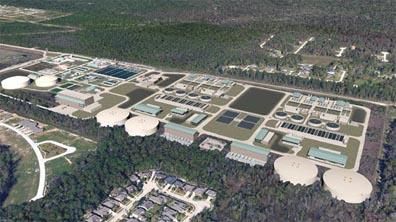Largest Water Purification Plant on the Planet
Published on by Water Network Research, Official research team of The Water Network in Maintenance
Houston begins building the largest water purification plant on the planet. The three-part expansion will increase water capacity 300 percent in the rapidly expanding northern suburbs.
The Northeast Water Purification Plant expansion project is underway near Lake Houston in Harris County, Texas.

Image source: Construction Online
Groundbreaking ceremonies signaled the start fo the three part project that will increase treated water capacity in the area to 320 million gallons per day.
The project includes the design and construction of a new raw water facility, which includes an advanced three-level intake, pumping, and conveyance to withdraw water from Lake Houston and deliver it through two new 108" pipelines to the treatment facilities located about 1.5 miles from Lake Houston.
The undertaking involves moving water three miles over a ridge and into a 23-mile canal that will feed Lake Houston, then pumped through 17 miles of pipe large enough to drive a car through.
The new facility is being developed by five parnters – the North Harris County Regional Water Authority, the West Harris County Regional Water Authority, the Central Harris County Regional Water Authority, the North Fort Bend Water Authority, and the City of Houston – who together to share the $1.35 billion cost.
The Greater Houston Water Department says that by 2025, surface water -- rather than groundwater -- must supply at least 60 percent of the water used by the area. That percentage will rise to 80 percent by 2035.
The new plant will treat Lake Houston water and turn it into drinking water. Additional demand for surface water will be offset by the Luce Bayou Interbasin Transfer Project which will draw water from the Trinity River and transfer it into Lake Houston.
Read full article: Construction Equipment
Media
Taxonomy
- Treatment
- Treatment Plants
- Water Treatment Solutions
- Water Supply
- Plant Economics
- Water Supply
- Water Utility
- Water Management
- Utility Management
- Water Treatment Plant Design
2 Comments
-
Bonjour L'homme vit dans cette bêtise depuis des lustres. Pourquoi cela changerait-il?
Je vais ajouter aussi l'envers du décors: plus d'alimentation d'eau (potable?) plus de production d'eaux usées. Une eau usée qui sera dispersée sans aucun traitement d'épuration réel dans l'environnement polluant les eaux de surface dans lesquelles ils vont pomper l'eau pour en faire de l'eau de consommation car le mot potable m'écorche la bouche.
Pour faire de l'eau potable la nature met des années: l'homme en cinq minutes va faire de l'eau, neutre, inerte, morte mais avec beaucoup de composants chimiques: argent, chlore et autres
L'homme a perdu la notion du -biologique-
English
Hello man has been living in this foolishness for ages. Why would that change?
I will also add the backwards of the decorations: more water supply (potable?) more sewage production. A waste water that will be dispersed without any real purification treatment in the environment polluting the surface water in which they will pump the water to make it water of consumption because the word drinking skin me my mouth.
To make drinking water nature puts years: Man in five minutes will make water, neutral, inert, dead but with many chemical components: silver, chlorine and other
Man has lost the notion of-biological-
-
Another wasteful project. More money, more chlorine, more disease, more medical bills, more health industry failures, less nutrition in foods, less potable drinking water, more hurricane damage to repair, more pollution dumping into the gulf expanding the dead zones. Lowering of the water table. Controlling water that should be free and charging outrageous prices. Not sustainable. Not environmentally sound.
If anyone can find one advantage let me know.
3 Comment replies
-
Note: high quality drinking water does not include chlorine. But does include seasalts
-
Sorry Gerry you were left in the dark for so long. I will explain in order of importance. #1. Drinking water was and is never supposed to be treated with chlorine. The original concept of a waste treatment facility in 1920 in NY had a bubbler unit to eliminate the deadly dangers of allowing chlorine into household drinking water. A number of health related industries convinced government officials to allow it. If your next comment is an allowable amount, scientifically speaking "there is no acceptable amount". #2. Rain water collection provides all of the water anyone could ever use in a lifetime. With modern technology waste recycling insitu is now possible with the residue being potable water and organic material for you compost pile. In addition during this process a biogenerator can be attached to collect loose electrons for your energy. #3. The money saved from NOT building infrastructure or 100 years of maintenance is vast. To make this easier for you to understand. Ground water will never be needed again, there will never be a need to dump waste in landfills or river to ocean again. Thus is NOT futuristic. It has been in use for 40 years where multinational companies and government politicians can not reach. We shall see how fast the swamp is drained so the American people can join the 21st century.
-
Guy, this is hardly a balanced and rational argument. The scheme is designed to REDUCE reliance upon groundwater, so why say that it will lower the water table? How can you justify your statement that the scheme to produce more, high quality drinking water will lead to "more disease, more medical bills, more health industry failures" and even "less nutrition in foods". I'm all for a lively debate about water resources, environmental impact and the issues around resilience of a large, centralised potable water treatment plant in what may increasingly become a hurricane-risk area. However I hope that we can keep the discussions on this forum factual, professional and rational.
-